International Spotlights 2021 Roundup by Susan M. Clark
December 22, 2021
Throughout 2021, Susan M. Clark (SDA Membership Committee member) has been researching and interviewing international SDA members about their life, work, and process. These interviews were published in our monthly newsletters, but in case you missed them here’s all of Susan’s artist spotlights from this year!
JANUARY 2021: CHIAKI DOSHO
Based in Kanagawa, part of greater Tokyo, Chiaki Dosho has been creating award-winning multi-media fibre artworks for about 20 years. Chiaki has exhibited throughout the world, and this year, she has had a solo installation show in Kyoto at Gallery Gallery, but many exhibition possibilities have slowed down, and Japan’s big quilt exhibition and fair was cancelled this year. Most recently, Chiaki participated in the December 2020 art quilt show at Tokyo’s majestic Gajoen. This year has been particularly challenging. When Chiaki tried to send one of her artworks to the upcoming Quilt National 2021, she learned that the US was not accepting air mail, and that she had to use seamail which took a nail-biting three months. When her artwork arrived in the US, it also had to be quarantined, but ultimately, it made it.
Chiaki came from an artistic family. A long time ago, she was teaching quilting in a patchwork quilting program and wanted to improve her lessons so she enrolled in a correspondence course with what is now Mushashino Art University’s textile program. Around this time, Chiaki also saw the ground-breaking solo exhibitions of Magdalena Abakanowicz and Anselm Kiefer at the Sezon Museum of Art, and she realized both the freedom that art could provide, along with the commitment it requires. Chiaki has immersed herself in the world of art beginning first with fashion, then patchwork, art quilts and ultimately fibre arts and mixed media. Working on her pieces can be all consuming, and she is grateful that during the 2011 Tōhoku earthquake, which was the most powerful earthquake ever recorded in Japan, she was completely preoccupied sewing an artwork, which helped distract her from unnecessary worry. Chiaki’s two children are adults with families of their own so she can dedicate her time to her art career.
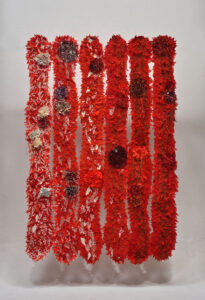
Chiaki Dosho, The Crossing Times 14, 2018. Silk kimono, 78 x 53 in. Photo: Akinori Miyashita.
FEBRUARY 2021: LOUISE WELLS
Please join me for a visit to Perth, Australia, to learn more about artist Louise Wells, and her work. Louise makes three-dimensional constructions, and amazingly, has exhibited in many shows in the past year. She uses dye, print, stitch and fabric manipulation and layering in repetitive, mediative processes, often leaving raw, cut, and frayed edges to create texture.
“My use of colour has changed over the years from strong bright colours to more subtle, mostly due to my increased use of recycled fabrics,” explains Louise. Her recent series Marking Time is created from recycled men’s business shirts destined for landfill. In early 2020, Louise started a new routine to begin each day with a brisk 3.6 km (2.25 mile) walk. Over time, she began to notice fine detail as she walked such as the blooms of the Australian native wildflower, Banksia, a type of protea. This artwork Marking Time emerged with daily steps, stitches and observations. When I asked Louise about how the pandemic affected her this past year, she explained, “We are extremely fortunate to be living in the most isolated city in the world within an island continent and have a Premier who chose to have a hard state border. We have therefore had no COVID community transmission for over 9 months. Consequently, WAFTA [The Western Australian Fibre and Textile Association] was able to hold an exhibition in September 2020, with over 106 members showing their work, over 4500 people safely visited the show over a three week period, while exhibitions of my work in other Australian states have either been postponed, cancelled or online viewing only.”
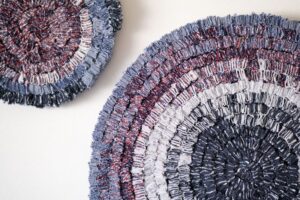
Louise Wells, Marking Time, 2020. Recycled men’s business shirts, folded, pleated, hand stitched, sizes vary. Photo: Josh Wells.
MARCH 2021: REGULA AFFOLTER
Switzerland-based Regula Affolter is a textile artist, part-time radiation specialist, skier, and gallery owner. She decides her time between Oekingen, a small agricultural community near Bern, the nation’s capital, and Klosters, a ski resort near Davos.
Regula makes art quilts incorporating hand-dyed fabrics and several printing techniques along with drawing and stitching. As a health professional working in a hospital’s emergency area, she has had close contact with Covid19 patients. She has made several artworks related to the recent pandemic in her series Crossing, with titles such as Impf (Vaccination), Flucht (Escape), and Social Distancing. She has also recently produced very colourful abstract pieces in another series unrelated to the pandemic called Konstrukionen. Artists seldom have art opportunities that relate directly to their employment, but Regula tells me that “[in] 2013 I received an invitation to participate in the Radiation exhibition at the 2014 European Congress on International Radiation Protection Association in Geneva. I started with this series of quilts and took a liking to screen printing at that time. With the sewing machine, I was able to add the missing details and draw them. Unconventionally and spontaneously, I implement my ideas in terms of color and shape. The works are created in a creative workflow, based on symbols and facts.”
In 2005, Regula organized the first workshop in Switzerland for Nancy Crow, and later organized exhibitions featuring artworks by Ann Johnston and Jan Myers-Newbury in her ArtQuilt Gallery.
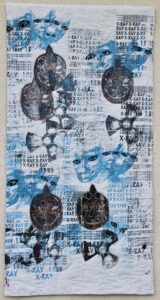
Regula Affolter, Jonisierende Strahlung#3/Serie Radiation, 2014. Cotton, screenprinted, machine stitched, 36 x 53 in.
APRIL 2021: SUNG RIM PARK
Sung Rim Park from South Korea, makes 3D sculptures and installations. She describes her work as, “Black and white threads symbolizing darkness and light, Hanji (traditional Korean paper handmade from mulberry trees), cord, and paper-wrapped-wire are repeatedly tied or woven to create a myriad of dots and lines in space. I gave shape to lights of twinkling stars in my embroidery works using those linear materials, and I made globular forms that represent completeness and eternity in my three-dimensional and installation works.” The night sky and cosmic space are her primary sources of inspiration, and the shape and scale of her work is determined by knots.
Based in Seoul, Rim is currently a visiting professor with Suwon University in Fiber Craft Design. She did her PhD in Fiber Arts in Korea, and an MA in Fine Arts at the Chelsea College of Art and Design in London. Rim also was awarded an Excellence Award for her Unpredictable Space 5 at Symbiosis and Coexistence, the 11th From Lausanne to Beijing International Fiber Art Biennale, which was available to view online from January to February 16, 2021. Rim has been very active during the past decade with eight solo shows, and as a participant in many group exhibitions at home in Korea and abroad. Her first solo show Construction was in 2010. In 2018, Rim was awarded an SDA Outstanding Student Award.
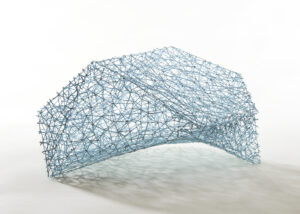
Sung Rim Park, Unpredictable Space 4, 2020. Cotton thread, knotted, 11 x 9.5 x 17.5 in.
MAY 2021: MONIKA AUCH
Monika Auch from the Netherlands, is a visual artist and former medical doctor. She researches the hand-brain axis and neuro-cognitive aspects of creativity and develops experimental, sculptural weaving.
In 2013, Monika conceived and launched Stitch Your Brain, a research project that has taken on a topical urgency. Participants throughout the world can order a kit with an embroidery canvas printed with Monika’s copyrighted design, a needle and assorted yarns. The website states: “Creating with your hands makes you happy. Embroidery, knitting, weaving, crochet and other craft activities release feelings of well-being in our brains. The project promotes slow crafting techniques to counterbalance our highly computerized environment.”
In 2016, Monika set up Weeflab in Amsterdam. Among its many activities, Weeflab enables art history grad students to explore Bauhaus weaving. Having been taught by a 2nd generation Bauhaus weaver herself she now explores the heritage of the German Bauhaus weavers that fled from Nazi Germany to Holland in the 1930s.
During a residency in 2019, Monika studied the ‘Colors of Norway.’ She restored an old loom and wove numerous wall panels on a salvaged linen warp. This artwork is a dynamic fusion of Ikat and Norwegian techniques with some structural Bauhaus textures. An article by Monika about a Norwegian basket maker is in the Spring 2021 Surface Design Journal.
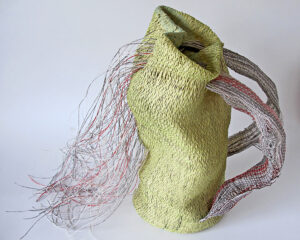
Monika Auch, Spine Stump (part of Stump Series), 2018. CAD weaving, 33.5 x 15.75 in. Photo by the artist.
JULY 2021: VIOLET SHIRRAN
Violet Shirran lives in another of those incredible mythical, historic places: Ireland. Violet attended the National College of Art and Design in Dublin, which originated in 1746. She studied metal sculpture and textile art.
“Ireland had the longest continuous lockdown in Europe and people were confined to exercising 2km and then 5km from their homes,” Violet explained when I asked her how the pandemic has been for her. She went on to tell me how her most recent art project emerged, “[I] began walking in local freshly ploughed fields and began collecting broken pottery shards which came to the surface, little treasures that offered solace in a difficult time. These pieces of crockery were called chainies in the 40s and 50s in Ireland and children invented games to play with them.” Due to the length of the lockdown and her many walks, her collection of chainies grew into hundreds, which she has sewn onto Khadi cotton paper with red thread representing her meandering walks and connected up into a continuous line.
From 2018 to 2020, Violet worked on The Repair Project combining environmental and emotional repair. “The public submitted hurtful statements which were said to them in their formative years that impacted on them, and I offered to embroider these statements in the hope of releasing them from their harmful effects,” she elaborated. Violet ended up embroidering over 100 pieces, some of which she did while installed in a gallery so members of the public could watch. An important component of this project was that she used naturally dyed vintage cloth.
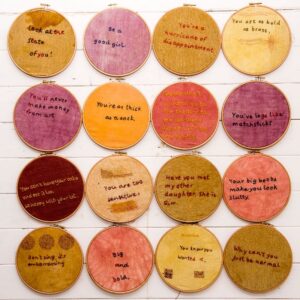
Violet Shirran, The Repair Project (detail), 2020. 16-8inch embroidery hoops, natural dyed fabrics, thread. Photo: Oisín Breannach.
AUGUST 2021: LAILA VÁZQUEZ
Laila Vázquez has a studio in her home in Mexico City, one of the major cultural capitals of the world. In her beautiful artworks celebrating Mexico, Laila works the surface using paper and textiles interchangeably. “I love to experiment with different textures of paper and thread. . . after much experimentation, I found that embroidering my water-colours and my prints directly on paper creates a perfectly balanced mix of my favourite techniques,” she explains.
Laila has introduced me to a number of different materials. Recently, she’s been using bark paper made by a community of Mexican women in San Pablito, a small town located on the side of the Guajalote Mountain in the Sierra Norte de Puebla. The paper is made in much the same way as it was before the Spanish arrived in Mexico. The threads she uses are made by women in Chiapas, and some of the threads are dyed with flor de cempasúchil (Mexican marigold) and cochineal. Her latest discovery is paper thread.
Some of Laila’s artworks depict cacti and plants. Even the plants are exotic to me, such as the maguey, which is native to Mexico and looks a bit like an aloe, but belongs to an unrelated genus. The nopal cactus, or prickly pear, also features in Laila’s art. It a common ingredient of many Mexican dishes, and also the food for crimson-dye producing cochineal insects.
When I asked how she has weathered the pandemic, Laila says, “Lately I’ve been more focused in landscapes, places that are not always real and that are an escape from lockdown through the imagination.” She also explains “I have used the internet like never before to find new connections with other artists and communities in places like Spain, Argentina, Australia, Canada, and England, where there is a great tradition of embroidery and textile art. It never ceases to amaze me that I’m only a click away from connecting with so many people that share my passion for these techniques.”

Laila Vázquez, Eagle or Sun, 2019. Watercolor, thread, cotton paper, 14 x14 in.
OCTOBER 2021: MICHELE LANDEL
Let’s take a trip to France to meet American Michele Landel who lives in Sèvres, part of greater Paris. Michele makes textured collages using burned, quilted and embroidered photographs and paper. She received an Innovation in Technique award with SDA’s 2018 Exhibition in Print. Until recently, she maintained a studio in Madeleine in Paris’ 8th arrondissement, but now she has a studio at home.
When I asked her how the past year and a half had been for her, Michele explains, “Last year was tough. I had five exhibitions canceled in three different countries, one gallery I worked with went out of business, and a large box of artwork that I had sent for an exhibition was lost and destroyed by the shipping company. I homeschooled my kids [ages 14, 10 and 7] for three months,” One of her most recent pieces, C-mon, Get up deals with her early experiences of the pandemic.
Being connected to the larger world and sharing ideas and talking about art is important to Michele and in 2020 she joined a crit group through the Artist/Mother Podcast, and then was invited to run her own group for them, “Talking with these amazing women and mothers once a month kept me inspired and focused on my art particularly through the long winter when France had 6pm curfews and we could only go 5km from our house.” She is also a member of the network, Thrive Artist Studio.
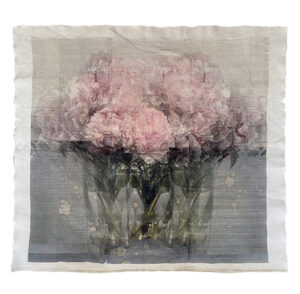
Michele Landel, Madame Blanchon, 2021. Photograph, antique bed sheets, thread, 25 x 27.75 in. Photo by the artist.
NOVEMBER 2021: JENNA NELSON
I would like to introduce Jenna Nelson from Finland. Jenna graduated from UC Davis with an MFA in Surface Design in 2019. The following year, she returned to Finland and set up her own brand Luova Flow, with “Luova” meaning creative in Finnish.
Jenna creates beautiful, magical, colourful nature-inspired prints for Luova Flow, and the brand’s first product was face masks. “Business has been quite good, considering the pandemic and that it is still early times for the brand. Luova Flow designs are sold internationally but the majority of customers are in Finland and the US. My experience running a design brand has been that it is fairly easy to work from almost anywhere,” she explains. Jenna has worked for Helsinki-based Vallila Interior and for Pottery Barn Teen, which taught her a wide range of things about the textile design industry and design studios of big brands. Of course, Jenna comes from a country with an incredible textile legacy, including the trailblazing 70-year-old Marimekko, which has just collaborated with Japanese Uniqlo. Luova Flow’s mission is to inspire people worldwide with magical designs, and it has certainly inspired me!
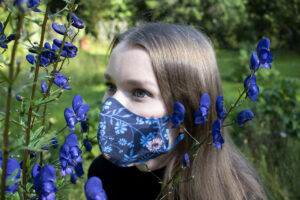
Jenna Nelson, Blue Floral Face Mask, 2020. Cotton fabric. Photo: Tina Pyörälä.


